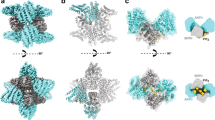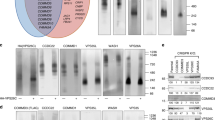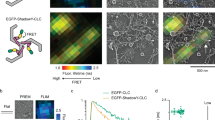Abstract
CLATHRIN is the structural protein of coated membranes involved in receptor-mediated endocytosis and aspects of Golgi sorting in eukaryotic cells. We have now detected a stoichiometric complex of clathrin with a novel protein of Mr ~100,000 (100K) in lysates of different mammalian cells. Formation of the complex, which also includes the 70K heat-shock protein HscTO, occurs within 15 min of synthesis. The 100K protein has been identified as valosin-containing protein (VCP; ref. 1), an early substrate for tyrosine phosphorylation on T-cell receptor activation2. Further, VCP is the mammalian homologue of yeast Cdc48p (ref. 3) and is a member of a larger gene family that includes putative ATP-binding proteins involved in vesicle transport and fusion4,5, 26S proteasome function6, regulation of the expression of human immunodeficiency virus7,8, and assembly of peroxisomes9. The association with clathrin and the morphological and catalytic similarity to the chaperonin proteins indicate that VCP may modulate protein-protein interactions in membrane transport processes.
This is a preview of subscription content, access via your institution
Access options
Subscribe to this journal
Receive 51 print issues and online access
$199.00 per year
only $3.90 per issue
Buy this article
- Purchase on Springer Link
- Instant access to full article PDF
Prices may be subject to local taxes which are calculated during checkout
Similar content being viewed by others
Author information
Authors and Affiliations
Rights and permissions
About this article
Cite this article
Pleasure, I., Black, M. & Keen, J. Valosin-containing protein, VCP, is a ubiquitous clathrin-binding protein. Nature 365, 459–462 (1993). https://doi.org/10.1038/365459a0
Received:
Accepted:
Issue Date:
DOI: https://doi.org/10.1038/365459a0
This article is cited by
-
VCP/p97 regulates Beclin-1-dependent autophagy initiation
Nature Chemical Biology (2021)
-
Variant in NHLRC2 leads to increased hnRNP C2 in developing neurons and the hippocampus of a mouse model of FINCA disease
Molecular Medicine (2020)
-
The valosin-containing protein is a novel mediator of mitochondrial respiration and cell survival in the heart in vivo
Scientific Reports (2017)
-
Proteomic analyses of age related changes in A.BY/SnJ mouse hearts
Proteome Science (2013)
-
A functional deficiency of TERA/VCP/p97 contributes to impaired DNA repair in multiple polyglutamine diseases
Nature Communications (2013)
Comments
By submitting a comment you agree to abide by our Terms and Community Guidelines. If you find something abusive or that does not comply with our terms or guidelines please flag it as inappropriate.



